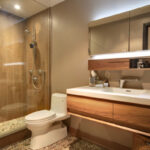When you’re out shopping for cutting boards, there’re many different options available in the market in terms of design and material. Three most common types of cutting boards include wood, marble and plastic; buying any would only add to the most significant items in the kitchen that simplifies chopping, cutting and slicing chores.
However, to think beyond the aesthetics and design is more important such as how to clean your chopping boards, proper use and maintenance in the long run so on. Bacteria easily find a living in the tiny cuts and creases on a board’s surface which is why cleaning is extremely important after treating meat, fruits, vegetables and other items.
Some agree that wooden cutting boards have a natural protection to bacteria and other such germs. On the contrary, plastic and marble are nonporous that even prevent liquids and juices from oozing into the surface. Let’s have a look at the three in detail!
Cutting boards;
- Wood
Perhaps the oldest and most common in all households is wooden cutting board that comes with many benefits and only a few demerits over synthetic alternatives. These wooden boards remain more “sanitised” since wood has natural tendency to ward-off certain germs and bacteria which leave it sterile. As for small gaps and cuts, they can close on their own!
Wooden chopping boards mustn’t be treated in a dishwasher or soaked in water for longer period as this would pessimistically affect the wood quality and glue. Simple rinse with hot water and a rub of white salt would surely get rid of foul odours. All you need is to sprinkle the salt on the board’s surface for a few minutes and rinse it with hot and clean tap water.
- Plastic
If you’re among the many other people who thinks that plastic cutting boards are more sanitised in nature as compared to wood; then perhaps it’s time to rethink as this isn’t the case. Plastic or polythene cutting boards are more prone to cuts and damage from knives and other pointy objects.
Unlike woods, even the gaps and certain slits to the surface won’t close themselves which soon become a breeding ground for many different germs and bacteria. Cleaning the plastic cutting boards can be done in a dishwasher but the only difference is of adding a little amount of dilute bleach mixture to the wash cycle.
- Marble
Most of the cutting boards made from marble are indeed expensive but cleaning and maintaining them in the long run is far easier. You can simply wash it in a hot and soapy solution, leave it to air dry! Since marble is a strong material, you needn’t worry about bacteria and germs hiding in cuts and crevices.
Doesn’t matter what type of cutting board you choose, they’ll surely protect the kitchen countertop by offering a handy solution and intermediary surface to work with knives and other hard, pointy objects.
Conclusion
When concerned with how to clean your chopping boards, let the above details guide you to keep them cleaned and maintained per the material type.



